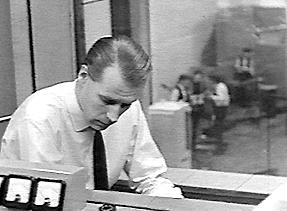“Please Please Me” Lycris
Last night I said these words to my girl,
I know you never even try girl,
C’mon (C’mon) C’mon (C’mon) C’mon (C’mon) C’mon (C’mon)
Please please me, whoa yeah, like I please you
You don’t need me to show the way, love
Why do I always have to say “love?”
C’mon (C’mon) C’mon (C’mon) C’mon (C’mon) C’mon (C’mon)
Please please me, whoa yeah, like I please you
I don’t wanna sound complaining,
But you know there’s always rain in my heart (in my heart).
I do all the pleasing with you it’s so hard to reason
With you, whoa yeah, why do you make me blue?
Last night I said these words to my girl,
I know you never even try girl,
C’mon (C’mon) C’mon (C’mon) C’mon (C’mon) C’mon (C’mon)
Please please me, whoa yeah, like I please you
Song History and Facts
“Please Please Me”
1962-1964
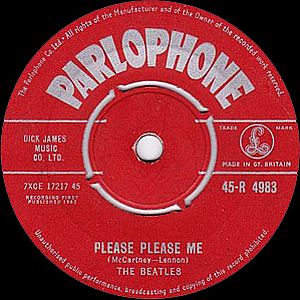
The Beatles’ first No. 1 hit in the U.K., “Please Please Me,” came in February 1963 on Parlophone records.
The song that really helped kick start the Beatles’ rocket ride to international fame and fortune in the early 1960s was “Please Please Me.” In the U.K. fifty years ago, in February 1963, “Please Please Me” was the song that first sent the Beatles’ music to the top of the music charts — their first No. 1 hit. It was also the song that energized “Beatlemania” in the U.K. – the screaming crowds that began besieging the Beatles at their stage appearances, generating media attention far and wide. “Please Please Me,” in fact, was the tipping point – the take-off song that changed everything. Within a year of this song’s release, the Beatles would be a worldwide phenomenon, their music selling practically everywhere.
True, the Beatles’ first hit song was “Love Me Do,” which rose to No.17 on the U.K. charts in November 1962. But “Please Please Me,” their second single, was the Beatles’ first popular “hard rocking” song; the song that captured their youthful exuberance and musical drive. It was also the song that first offered that unique “Beatles’ sound”– an appealing mix of young male vocals in sync with driving guitars. “Please Please Me” captured that sound in an aggressive and engaging way. It was feel good music that was fresh, open, and hopeful. The public ate it up.
| Music Player “Please Please Me”-1963 |
John Lennon sang lead and played harmonica on the song, George Harrison played lead guitar, Paul McCartney was on bass, and drummer Ringo Starr delivered the back beat. McCartney and Harrison also supplied the harmony and background vocals. It was a sound the world hadn’t quite heard before – and a sound, as time would tell, that would turn music to gold.
Initially, however, “Please Please Me,” as originally written by John Lennon, didn’t have the chops to make it as a No. 1 hit – at least not in the eyes of George Martin, the person then in control of the Beatles’ fate in their first London recording sessions. In fact, “Please Please Me” almost didn’t make it at all.
In the U.S., meanwhile, this song also had something of a tortured history. Although it was released in America in early 1963 as it had been in Britain, it went largely unnoticed. “Please Please Me” would not fully emerge as a U.S. hit until more than a year later, in March 1964, when it would join four other Beatles’ songs to occupy the top five positions on the U.S. Billboard charts. But the story of “Please Please Me” in America captures some of the confusion, bungled business opportunities, and the general whirlwind that came with the Beatles euphoria in those crazy early days. More on that in a moment.
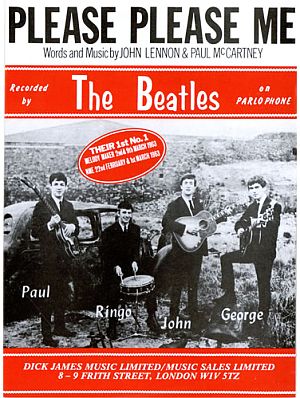
Sheet music cover for the Beatles’ “Please Please Me” issued by Dick James Music, Ltd., London.
“Please Please Me” was a John Lennon composition. Lennon described the inspiration for the song as coming from a combination of Roy Orbison and Bing Crosby influences. He wrote the song at his aunt Mimi’s house, having been listening at the time to some Roy Orbison tunes. Lennon was also taken with a line from Bing Crosby’s 1932 song, “Please” – the line being, “Please lend your little ears to my pleas…” Lennon said he loved “the double use of the word ‘please’.”
Paul McCartney pointed back to Orbison’s style. “If you imagine [Please Please Me] much slower,” McCartney said of the song, “which is how John wrote it, it’s got everything. The big high notes, all the hallmarks of a Roy Orbison song.”
In 1962 Lennon’s song was offered initially at the Beatles’ first London studio session in its slower form. George Martin, the studio engineer and manager of EMI’s Parlophone label, and the guy who had signed the Beatles in 1962, did not like Lennon’s song when he first heard it. He found it too slow and reportedly called it “a dirge” at one point. He suggested the song’s tempo be sped up and that the Beatles try a different arrangement. Reportedly, Martin also played a sped-up taped version of the song from an earlier recording that served as something of an “ah-ha” moment for the group. But Martin wanted the Beatles to record another song at their next session at Abbey Road studios on November 26th, 1962, one the Beatles had not written themselves.
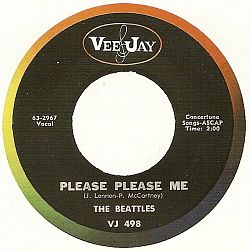
Early Vee-Jay single of Beatles’ “Please Please Me,” released in the U.S. 1963, is distinguished by ‘Beattles’ misspelling, later corrected.
However, the Beatles prevailed on Martin to let them take another crack at “Please Please Me.” They had taken Martin’s suggestions on the song, sped it up, and added Lennon’s harmonica to the arrangement. “We lifted the tempo, and suddenly there was that fast Beatles’ spirit,” McCartney later recalled. The song was now much better. Still, it went through a series of more than a dozen studio takes before Martin was satisfied – and this time, he liked what he heard. “Gentlemen,” he is reported to have said from the recording booth to the group after the new version was completed, “I think you’ve got your first Number One.” After the Beatles’ first national TV appearance on U.K.’s Thank Your Lucky Stars show on January 19, 1963– which featured “Please, Please Me” – the song began its rise on the U.K. singles charts, hitting No. 1 on February 22nd, 1963.
In the U.S., meanwhile, George Martin had sent a copy of “Please Please Me” to EMI’s U.S. subsidiary, Capitol Records, in January 1963, urging executives there to distribute Beatles’ songs in the U.S. They declined, saying famously: “We don’t think the Beatles will do anything in this market.” Atlantic Records was also offered a chance to distribute “Please Please Me” in the U.S., but they also declined. At that point, other record labels began looking at the Beatles’1963 songs for U.S. release. One of these labels was Vee-Jay out of Chicago, an African American-owned label founded in the 1950s specializing in blues, jazz, rhythm and blues, and rock and roll.

Brian Epstein, who discovered the Beatles and became their manager, also negotiated early business deals and arranged for publicity.
On January 25, 1963, Vee-Jay obtained a U.S. contract to release a limited number of Beatles records for short time period. Sometime in February 1963, “Please Please Me,” w/ “Ask Me Why” on the B side, was released as a single on the Vee-Jay label. The song was played on Chicago’s WLS radio station where it rose to No. 35 on WLS music survey in March 1963. But “Please Please Me” did not chart nationally on Billboard at the time. The record, in fact, was a commercial flop at that point, selling fewer than 7,500 copies.
Back in Britain in 1963, “Please Please Me” was doing so well that Beatles’ manager Brian Epstein pulled the Beatles off their tour schedule to record their first album, naming it Please Please Me to capitalize on the popularity of the single. Some 14 songs – including “I Saw Her Standing There” as the lead track – were compiled for that album in one day after nine hours of recording over three sessions. The new Please Please Me album was released in late March 1963. Within four weeks it would be No.1 on the U.K. albums chart, remaining in that position for 30 weeks. New Beatles’ singles were also released in the U.K. through 1963, and these resulted in three more No. 1 hits: “From Me to You” w/ “Thank You Girl” in April 1963; “She Loves You,” w/ “I’ll Get You” in August 1963 ( which achieved the fastest sales of any record in the U.K. up to that time, selling 750,000 copies in less than four weeks); and “I Want To Hold Your Hand” w/ “This Boy” in November 1963, which had 1 million advance U.K. orders.
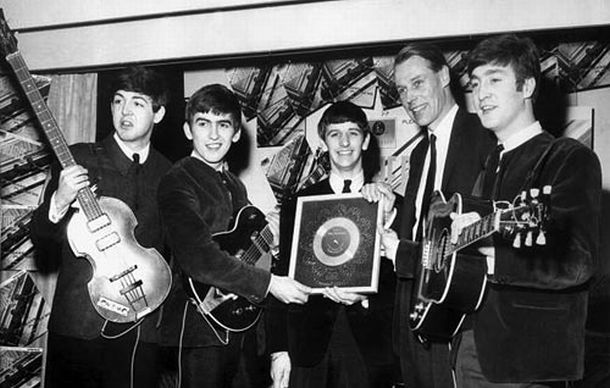
April 1963: Beatles with George Martin at EMI House in central London receiving their first silver disc for sales of more than 250,000 copies of “Please, Please Me.”
In the U.S., meanwhile, Brian Epstein in November 1963 phoned Capitol Records president, Alan Livingston, about the label’s refusal to distribute Beatles songs in America. Epstein played the Beatles’ latest U.K. hit song for Livingston over the phone — “I Want To Hold Your Hand” – and also mentioned to Livingston that the group was scheduled for February 1964 TV appearances onThe Ed Sullivan Show. Livingston agreed to begin spending some serious money distributing and promoting Beatles’ songs in the U.S. On December 4th, 1963, Capitol announced it would begin selling “I Want To Hold Your Hand” in mid-January 1964. But after a few radio DJ’s in America began playing the song, Capitol undertook a rush production schedule to release “I Want To Hold Your Hand,” then targeting release for the day after Christmas, December 1963.
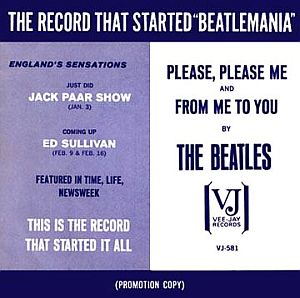
Vee-Jay’s promotional cover sleeve for Beatles’ ‘Please Please Me’ single following Jack Paar show, Jan 1964.
On January 3, 1964, Jack Paar, host of the late night U.S. TV talk show, “The Jack Paar Show,” aired a filmed segment of a Beatles’ performance of “She Loves You” from England. It was the first complete Beatles song aired on American TV, and for many Americans, the first time they had seen or heard the Beatles. Meanwhile, Capitol Records’ early release of “I Want To Hold Your Hand” proved wildly successful. By January 10, 1964, two weeks after the release, the single has sold 1 million copies – a staggering number at that time for an unknown music group from overseas.
Vee-Jay records, for its part, seeing the rising tide for all things Beatles, decided to take another shot at “Please Please Me,” and in mid-January 1964 re-issued the single, this time, with “From Me To You” on the “B” side. Some of Vee-Jay’s promotional record sleeves for the single featured headlines printed on the jacket that read: “The Record That Started Beatlemania,” and other text description noting the Beatles’ clip on The Jack Paar Show, their upcoming Ed Sullivan Show appearances, and press coverage in Time, Life and Newsweekmagazines. “This Is The Record That Started It All,” said the Vee-Jay record sleeve. By January 25, “Please Please Me” finally entered the American Billboard chart at No. 69, soon rising to No. 1. Vee-Jay would sell at least 1.1 million copies of “Please Please Me” in its second offering, and would also sell at least four other Beatles’ singles, as well as the Beatles’ first U.S. album, Introducing…The Beatles, which came out ten days before Capitol’s Meet the Beatles!, also in January 1964.
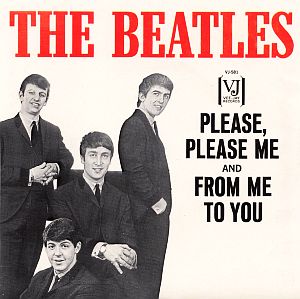
Cover sleeve for the re-issued single of the Beatles’ “Please Please Me” in America by Vee-Jay Records.
“Please Please Me,” however, was just the beginning of the Beatles’ phenomenal rise in America during 1964. After their first national TV appearance on The Ed Sullivan Show on February 8th when more than 70 million tuned in, their songs dominated the American music charts. In 1964 alone, the Beatles put 19 hit songs in the Top 40, and 30 in the Top 100. In fact, between January and March 1964, the Beatles accounted for 60 percent of all record sales in the U.S. Fifteen of their recordings in 1964 – nine singles and six albums – each sold one million or more copies, representing total Beatles’ record sales that year of more than 25 million copies.
“Please Please Me” may not be regarded as the Beatles’ best song ever by music critics or many of their fans, but it is certainly among the most important for launching their career, energizing their early style, and showing how adaptable and creative they could be when faced with criticism in the studio. In a special Rolling Stone magazine supplement of November 2010 reviewing the Beatles’ 100 greatest songs, “Please Please Me” is ranked at No. 20. Today, the song is still sold and downloaded by fans via Amazon.com, Apple’s iTunes music store, and other music sellers. For other stories on the Beatles at this website see “Beatles History: Eight Stories,” a sub-directory page with other Beatles’ story choices. Thanks for visiting. – Jack Doyl
Thanks to pophistorydig.com
—————————————————————————————————————————————————————–
Other Tidbits
John Lennon, who was a big Roy Orbison fan, wrote this in the style of Orbison’s overly-dramatic singing. Beatles producer George Martin suggested it would sound better sped up. In 2006, Martin told The Observer Music Monthly, “The songs the Beatles first gave me were crap. This was 1962 and they played a dreadful version of ‘Please Please Me’ as a Roy Orbison-style ballad. But I signed them because they made me feel good to be with them, and if they could convey that on a stage then everyone in the audience would feel good, too. So I took ‘Love Me Do’ and added some harmonica, but it wasn’t financially rewarding even though Brian Epstein bought about 2,000 copies. Then we worked for ages on their new version of ‘Please Please Me’, and I said: ‘Gentlemen, you’re going to have your first number one’.” (thanks, Edward Pearce – Ashford, Kent, England)
The group’s name was misspelled “Beattles” on the record label on the first American release.
The Beatles performed this on their second Ed Sullivan Show appearance in 1964. Sullivan was not a fan of many Rock groups, but loved The Beatles and had them on his show whenever he could.
This was the second Beatles single released in England, the first being “Love Me Do.” (thanks, Edward Pearce – Ashford, Kent, England)
The “Please Please Me” album was The Beatles debut long player. When they recorded it at Abbey Studios in London, John Lennon was struggling with a streaming cold and all were tired after a tour supporting Helen Shapiro. However with the help and encouragement of producer George Martin within nine hours and 45 minutes they had recorded their groundbreaking LP.
An early version of this song with session drummer Andy White playing drums instead of Ringo can be found on Anthology 1. (thanks, Bertrand – Paris, France)
The Beatles performed this on Thank Your Lucky Stars on January 19, 1963. It was their first ever UK television appearance.
The British Prime Minister Gordon Brown revealed in an interview on the British TV program GMTV that this was the first record that he ever bought.
“Please Please Me” Guitar Chords and Tabs:

